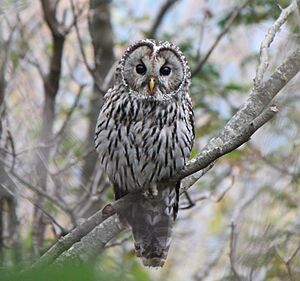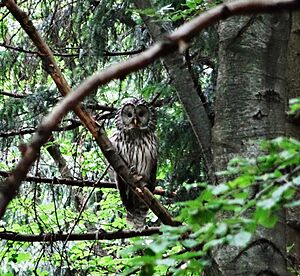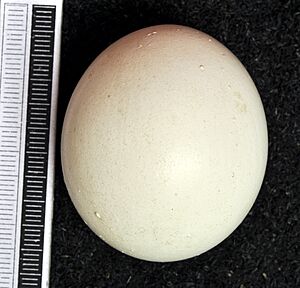Ural owl facts for kids
Quick facts for kids Ural owl |
|
|---|---|
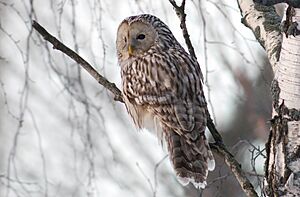 |
|
| Conservation status | |
| Scientific classification | |
| Genus: |
Strix
|
| Species: |
uralensis
|
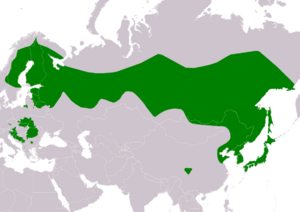 |
|
| Range of S. uralensis Resident | |
The Ural owl (Strix uralensis) is a large nocturnal owl. This means it is mostly active at night. It belongs to the true owl family, called Strigidae. The Ural owl is part of the Strix group of owls. Both its common name and scientific name come from the Ural Mountains in Russia. This is where the first owl of its kind was found. However, this owl lives in many places. Its home stretches from Scandinavia in the west, across Russia, all the way to Sakhalin and Japan in the east. There might be up to 15 types, or subspecies, of the Ural owl. But some scientists think there are fewer.
This forest owl usually lives in the huge taiga forests of Europe and Asia. It can also live in other types of forests, like mixed forests and temperate deciduous forests. The Ural owl eats many different things, like other Strix owls. But it mostly hunts small mammals, especially small rodents like voles. When it comes to having babies, Ural owls strongly protect their nesting areas. They have nested in natural spots like tree holes and old nests made by other birds. Today, in many places, they use nest boxes built by biologists and conservationists. How well they breed often depends on how many prey animals are around. The Ural owl is a stable species. The IUCN lists it as a least concern species. This means it is not currently at risk of disappearing. Even with some local drops in numbers, reintroducing them has helped the Ural owl in central Europe.
Contents
What Does the Ural Owl Look Like?
Like most Strix owls, the Ural owl has a wide, round head. Its face looks like a round disc. It has a very long tail that looks like a wedge at the end. Its feathers are usually a light grayish-brown to whitish color. Its back is a bit darker, with white marks. Its belly is pale cream or grayish-brown with dark brown stripes. The color of their feathers can vary a lot, even among owls of the same type. But generally, the Ural owl looks like a pale grayish-brown owl with clear stripes on its belly.
When it flies, you can see its buffish-white underwings with dark bars. Its long, white-tipped tail often hangs down. It flies like a buzzard, with slow, deep wing beats. This makes it look like a very large bird. Its eyes are dark brown, small, and close together. This makes them look less "fierce" than a great grey owl. Their eyes are shaped like almonds. The bill is yellowish, and its feet and toes are covered in grayish feathers. Its talons are yellowish-brown with darker tips.
Size and Weight of Ural Owls
The Ural owl is a large bird. It can be from 50 to 64 cm (20 to 25 in) long. This makes it one of the eight longest owl species in the world. Its wings can spread from 110 to 134 cm (3 ft 7 in to 4 ft 5 in) wide. Like most birds of prey, female Ural owls are a bit bigger than males. This is called reverse sexual dimorphism. In Finland, scientists found that talon size and weight are the best ways to tell males and females apart.
Male Ural owls can weigh from 451 to 1,050 g (0.994 to 2.315 lb). Females can weigh from 569 to 1,454 g (1.254 to 3.206 lb). The Ural owl is one of the biggest owls in the Strix group. It is about 25% smaller than the great grey owl, which is the largest Strix owl.
How Ural Owls Communicate
Sounds and Calls
The male Ural owl's song is a deep, steady series of notes. It sounds like "wihu huw-huhuwo" or "huow-huow-huow". The song repeats every few seconds. People can hear the male's song up to 2 km (1.2 mi) away. In Finland, they sing most often from 10 pm to midnight and from 1 am to 3 am in springtime. The female's song is similar but rougher and higher-pitched, sounding more like a "bark." Ural owls often sing together during courtship.
They also make a deep, rough "kuwat" or "korrwick" sound to keep in touch. These calls are longer and harsher than the calls of tawny owls. Young owls make hoarse "chrrreh" calls when they want food. These are similar to young tawny owls but deeper. Owls vocalize most from early spring until the young leave the nest. This often happens when the female is incubating eggs or when young are being fed. The male's alarm call sounds like the territorial song of a short-eared owl. It is a hollow hoot. This alarm call can be heard up to 1,500 m (4,900 ft) away. Ural owls also snap their bills loudly when they feel threatened. Scientists in Sweden have noted about nine different calls from Ural owls. Despite this, they are usually very quiet for large owls. They might not make any sounds for almost two days, even during busy times.
Amazing Hearing of the Ural Owl
Ural owls have very large ears. The left ear is about 24 mm (0.94 in) and the right is about 27 mm (1.1 in). Their ears are among the largest found in owls. Along with their well-developed facial disc, these large ears show how important sound is for hunting. This is especially true for owls that hunt in boreal zones. The Ural owl's hearing is better than other Strix owls like the barred owl. However, it's not as developed as owls that live only in true boreal habitats, like the great grey owl or the boreal owl.
How to Tell Ural Owls Apart from Other Owls
The Ural owl looks quite unique, but it can sometimes be confused with other owls, especially those in the Strix group.
- The barred owl from North America looks very similar. The main difference is that the Ural owl does not have circles on its face.
- The tawny owl is much smaller. It has a shorter tail and a bigger head. Tawny owls can be grey, brown, or red. They have dark streaks and crossbars on their bellies, unlike the straight stripes of the Ural owl.
- The great grey owl is larger than the Ural owl. It has a huge head and even smaller yellow eyes. Its face has strong circles. The great grey owl is also a more solid, darker grey than the Ural owl.
- It's unlikely to confuse a Ural owl with a Eurasian eagle-owl. The eagle-owl is much bigger. It has noticeable ear tufts, a square head, and orange eyes. Its markings are also very different.
- Long-eared owls are much smaller and thinner. They have clear ear-tufts, orange eyes, and darker markings.
- The Père David's owl is a close relative. It lives in a different area. It is darker and has dark circles on its face.
- Some people might confuse it with a Eurasian goshawk because it can fly during the day. But goshawks look very different.
Ural Owl Family Tree
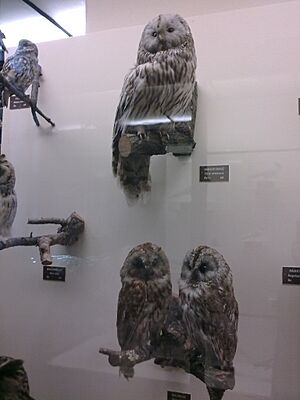
The Ural owl was named by Peter Simon Pallas in 1771. He called it Strix uralensis because the first owl found was in the Ural mountains. Some scientists wished it had a more general English name, as its home is much wider than just the Urals. In other languages, it has names like "attacking owl" (Swedish), "goshawk-owl" (German), or "long-tailed owl" (Russian).
The Ural owl is part of the Strix group, often called wood owls. This group has about 18 species. They are medium to large owls with round heads and no ear tufts. They live in forests in different climates. Strix owls have a long history, with many fossils found.
Scientists believe the tawny owl is a close relative of the Ural owl. They think that during the Pleistocene ice ages, one group stayed in warmer forests (the tawny owl). Another group moved east to cold, boreal ranges (the Ural owl). Even though they have similar lives, they look different and live in different climates and habitats. Fossils show owls that were in-between the Ural and tawny owls.
Some American owls, like the barred owl and spotted owl, are also thought to be closely related. However, there's no proof that owls from America and Eurasia were ever one group. The Père David's owl is a bit of a mystery. It has been seen as a separate type of Ural owl or its own species. Recent studies suggest it is a unique species.
Types of Ural Owls (Subspecies)
Some experts recognize up to 15 subspecies of Ural owls, while others think there are as few as eight. Genetic studies in Europe show about 5 different genetic groups. These groups don't always match the subspecies perfectly. This suggests that Ural owl populations were once connected. Human activities might have caused some populations to become isolated.
Here are some of the main subspecies:
- S. u. uralensis (Pallas, 1771): This is the original type. It lives in parts of Siberia and the Ural mountains. It is likely the palest type of Ural owl. Some look so white they might be mistaken for a snowy owl.
- S. u. davidi (Sharpe, 1875): The Père David's owl. It lives in the mountains of central China. Scientists are still debating if it's a separate species or a subspecies.
- S. u. liturata (Tengmalm, 1795): Found in northern Europe, including Norway, Sweden, and Finland. These owls are similar to the original type but a bit darker.
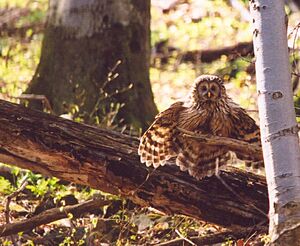
- S. u. macroura (Wolf, 1810): This is the largest type of Ural owl. It lives in the Carpathian mountains in Europe. It is probably the darkest type. Some are very dark brown, called "dark morphs."
- S. u. yenisseensis (Buturlin, 1915): Found in the Central Siberian Plateau and Mongolia. It is similar to the original type but usually smaller.
- S. u. nikolskii (Buturlin, 1907): This type lives in Sakhalin and the Korean peninsula. It is quite small, only slightly larger than the Japanese Ural owls.
- S. u. fuscescens (Temminck & Schlegel, 1847): This Japanese type lives in western and southern Honshu to Kyushu. It is quite small. Its feathers are yellowish-brown with dark brown streaks.
- S. u. hondoensis (Clark 1907): Found throughout Hokkaido and northern and central Honshu. Surprisingly, the owls in the colder north (Hokkaido) are the smallest. These owls are often a rusty brown color.
Where Ural Owls Live
The Ural owl lives in a very large area. In Europe, it's found in scattered spots. These include parts of southeastern Germany, the Czech Republic, southern Austria, and much of Poland. It also lives in eastern Europe, like Croatia, Bosnia and Herzegovina, Romania, and Slovakia. In Scandinavia, it's widespread in most of Sweden and Finland.
Its range in Russia is huge, but it avoids areas without good habitat. It lives across Siberia and into the Russian Far East. Outside of Russia, it's found in northeastern Mongolia, northeastern Northeastern China, and the Korean Peninsula. The Ural owl also lives on all five main islands of Japan. Sometimes, Ural owls wander far from their usual homes. There have been sightings in northern Italy.
Ural Owl Homes (Habitat)
Ural owls like mature, but not too dense, old forests. These can be coniferous (like pine and spruce), mixed, or deciduous (like birch and alder) forests. They usually prefer to be near an open area, like a clearing. These clearings might be near wet areas with spruce, alder, or birch trees. In many parts of their range, the main trees are spruce, fir, and pine. In the south, they might live in alder, beech, and birch forests mixed with conifers. They often live in high mountain forests. But in wild, remote areas, they can also live at sea level.
In the Carpathian mountains, they mostly live in beech forests. These forests are usually at elevations of 250 to 450 m (820 to 1,480 ft). They need at least 100 ha (250 acres) of woods, with some parts being at least 45–60 years old. Carpathian Ural owls usually stay away from human homes. They also avoid steep slopes or very dense undergrowth. They like areas with gaps between trees, about 25 m (82 ft) wide, and plenty of broken trees. Young owls might use wooded paths to connect to good habitats. Slovakia, Slovenia, and Romania have the best habitat in the Carpathians. This is why they have the most Ural owls in Europe.
Historically, Ural owls lived in remote, undisturbed areas. They avoid places where forests are broken up or look like parks. This is different from the smaller tawny owl, which can live in such areas. However, in some city areas of Russia, Ural owls have successfully lived in parks and gardens. This happens if there's enough good habitat and prey. Some cities where Ural owls have been seen include Kirov and Irkutsk. In Finland, the use of nest boxes has allowed Ural owls to nest closer to people.
Ural Owl Behavior
The Ural owl is often considered nocturnal, meaning it's active at night. It's most active at dusk and just before dawn. However, in places like the taiga, where summer days are very long, Ural owls are often active during the day in warmer months, especially when raising young. In winter, they are mostly active at night. So, they can be called cathemeral, meaning they are active at different times. Their relatively small eyes also suggest they can be active during the day. This is different from the tawny owl, which is almost always nocturnal. During the day, Ural owls rest on a branch close to a tree trunk or in thick leaves. They are usually not very shy and can be approached closely.
Protecting Their Home (Territoriality)
The Ural owl is very territorial. It tends to stay in the same home area all year. Most boreal owls, like the great grey owl, move around a lot depending on their prey. But the Ural owl rarely leaves its home, even when prey numbers drop. Like most Strix owls, they are very territorial and don't migrate. Males usually sing to protect their territory. There are not many direct observations of fights between adult owls, but they are known to be aggressive when protecting their nests.
Young owls might travel up to 150 km (93 mi) from their birth area. A few might even travel farther and stay in a wintering area. In severe winters, Siberian owls might move south if prey is scarce and it's too cold.
What Ural Owls Eat
The Ural owl is a strong hunter. But like most owls, it prefers to catch small prey, especially small mammals. In most studies, between 50% and 95% of their food is mammals. They mostly eat different kinds of rodents. Shrews and, in some areas, moles are also common food. They can also catch other small mammals, up to the size of young hares. They also eat birds, amphibians, and invertebrates. Reptiles and fish are very rare prey. The Ural owl is known to eat over 200 different prey species, with more than 80 being mammals.
They usually hunt from a perch. They prefer prey that comes into open areas of the forest. In Slovakia, Ural owls have learned to hunt in open areas created by humans, like forest clearings and even farms or small towns next to forests. They often perch on a tree and wait for prey to appear. In Scandinavia, Ural owls hunt more like goshawks. They fly in short bursts from perch to perch, trying to be quiet until they spot prey. They almost always drop down on prey directly from their perch. They don't usually attack prey while flying.
In Japan, studies showed that Ural owls learn which areas have more food. They also prefer to hunt larger prey. They can hunt prey hiding in shallow snow or near the surface. But they can't reach voles hiding deep under the snow in tunnels. They might store extra food near their nest. There's even a record of a Ural owl eating a dead roe deer.
Mammals: Their Favorite Meal
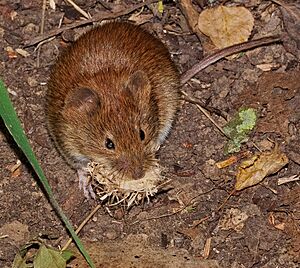
Voles, which are small rodents with short tails, are the most important part of the Ural owl's diet. In Europe, they often eat field voles and bank voles. These voles live in open areas near forests and can be very numerous when their populations are high. In Finland, Ural owls preferred a larger vole, the European water vole. This vole made up over half of the owls' food by weight in one study.
As Ural owls live further south, prey populations are less up and down. But they also seem to have less access to large prey like water voles. In Latvia, voles made up about half of their diet. In Poland, they mainly ate bank voles, common voles, and yellow-necked mouses. In Slovenia, a large part of their diet was dormice, especially the large edible dormouse.
Further east, in Russia and Japan, Ural owls still mostly eat small rodents. In Primorsky Krai, they ate northern red-backed voles and reed voles. In Japan, they mostly ate Apodemus species (field mice) and voles.

Ural owls also eat nearly 20 species of shrews. Shrews are very small, so they don't add much to the owl's total food weight. But they can help the owls avoid hunger. The smallest mammal they eat is the Eurasian least shrew, which weighs about 2.5 g (0.088 oz). They also sometimes eat bats, flying squirrels, and weasels.
Larger mammals are also eaten, but not as often. These include squirrels, rats (like the 300 g (11 oz) brown rat), and hedgehogs. They have even been known to eat the Japanese giant flying squirrel, which weighs about 1,150 g (2.54 lb). Hares are another large prey item. They don't eat many hares, but hares can make up a lot of the food weight. Ural owls usually hunt young hares. In Europe, they hunt European hares and mountain hares. Young mountain hares can weigh about 500 g (1.1 lb).
Other Foods Ural Owls Eat
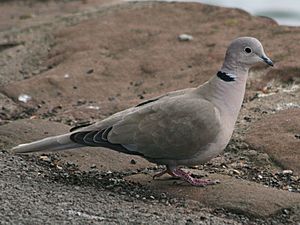
After mammals, birds are the next most important food group. Ural owls eat over 100 different bird species. Birds usually make up less than 10% of their diet in Europe. However, in Fennoscandia, when vole numbers are low, birds become more important. In bad vole years in Finland, birds made up over 30% of their diet. Thrushes were the most common birds eaten.
In the city of Košice, Slovakia, urban Ural owls mainly ate pigeons and doves, like Eurasian collared doves and rock pigeons. In Russia, birds were more significant in the Urals diet. In Japan, birds are also a more common part of their diet. They often eat small birds like the Eurasian tree sparrow.
Ural owls seem to hunt birds based on chance. They don't seem to specifically look for certain types of birds. Most birds they eat are small, like a chaffinch (23.9 g (0.84 oz)) or a Eurasian jay (160 g (5.6 oz)). They can even catch tiny birds like the goldcrest (5.2 g (0.18 oz)). They sometimes eat corvids (like crows), but not as often as other predators. They also eat gamebirds and woodpeckers. Rarely, they might catch birds as large as themselves, like an adult mallard or black grouse.
Reptiles are very rare prey for Ural owls. This is because there aren't many reptiles in the cold places where Ural owls live. However, they sometimes eat frogs in warmer months. Frogs and other amphibians usually make up less than 6% of their diet. There's no confirmed record of them eating fish.
Ural owls don't usually hunt insects or other invertebrates because they are too small for a large owl. But sometimes, they might eat a lot of woodboring beetles. In the Bavarian Forest, insects made up over 6% of their diet. In Japan, they have been seen eating Japanese rhinoceros beetles. They have also been recorded eating Daurian crayfish.
Ural Owls and Other Predators
Ural owls often live in the same areas as other owl species. Many of these owls also hunt small mammals, especially voles. So, Ural owls often compete with other owls. The Ural owl is often compared to its close relative, the tawny owl. They live together in many parts of Europe. Both owls eat similar prey. However, the Ural owl is much larger and has bigger talons. This helps it catch larger mammals.
When their ranges overlap, the Ural owl usually dominates and sometimes kills the tawny owl. But these killings are rare. The tawny owl is not as well suited to taiga habitats as the Ural owl. Also, the tawny owl has fewer places to nest, while the Ural owl can use old bird nests and tree stumps.
The great grey owl also lives in much of the Ural owl's range. Despite its large size, the great grey owl mainly eats voles. Its feet and talons are smaller and less powerful than the Ural owl's. This difference in diet and nesting habits helps them avoid too much competition.
The Eurasian eagle-owl is much larger than the Ural owl. It is about three times heavier. The eagle-owl also eats many small prey, but it can eat a much wider variety of food. It also lives in more types of habitats. Being much larger and stronger, the eagle-owl can catch much bigger prey than the Ural owl. Ural owls likely avoid eagle-owls.
Most other owl species that the Ural owl meets are much smaller. The Ural owl usually dominates these smaller owls. The boreal owl often shares similar habitat and prey with the Ural owl. However, boreal owls seem to avoid tawny owls more strictly. Studies show that boreal owls might benefit when dominant Ural owls keep tawny owls away. But boreal owls also face higher death rates if they nest too close to Ural owls (within about 2 km (1.2 mi)). A similar relationship exists with the Eurasian pygmy owl, which is less than half the size of a boreal owl.
Who Hunts the Ural Owl?
Ural owls can sometimes be hunted by larger predators. The most dangerous predator is likely the Eurasian eagle-owl. Other known predators include golden eagles, eastern imperial eagles, mountain hawk-eagles, and Eurasian lynxes. Even slightly larger diurnal raptors like the northern goshawk and lesser spotted eagle can prey on them. Young Ural owls, especially those recently released, have been hunted by red foxes, European pine martens, and great grey owls. In some areas, Asian badgers and raccoon dogs might also attack Ural owl nests. There was even one case where an American mink killed and ate a Ural owl.
However, attacks on Ural owls are very rare. Outside of the Arctic, the Ural owl is considered one of the owl species least likely to be preyed upon, second only to the apex predator eagle-owls.
The Ural owl itself is a strong predator of smaller owl species. It has been known to hunt northern hawk owls, tawny owls, Eurasian pygmy owls, boreal owls, and long-eared owls. They also sometimes prey on diurnal raptors (birds of prey active during the day). These include grey-faced buzzards, Eurasian sparrowhawks, common kestrels, and even adult northern goshawks. This means the Ural owl holds a similar position in the food chain as the goshawk. In Finland, smaller owls and diurnal raptors seem to avoid nesting near Ural owls. Ural owls have also successfully chased away nesting goshawks, European honey buzzards, common buzzards, and black kites to claim their nests.
Ural Owl Reproduction and Life Cycle
Pairing and Territory
The Ural owl usually stays with the same mate for life. They keep the same territory for many years. In Fennoscandia, almost all males (98–100%) and most females (90-95%) stayed with their mate. This makes them one of the most loyal birds of prey. Ural owl territories are about 3 times larger than tawny owl territories. In Sweden, there are about 3000 pairs of Ural owls in a 150,000 km2 (58,000 sq mi) area. In Finland, nests are usually 2 and 4 km (1.2 and 2.5 mi) apart in wild areas.
Nesting Spots
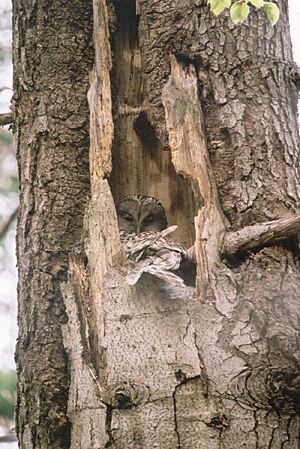
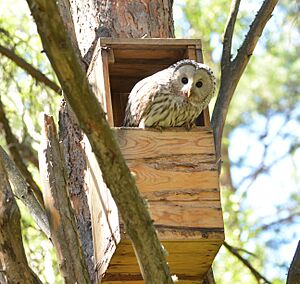
Ural owls can nest in many places. They use large natural holes in trees, cavities from broken branches, hollow trunks, or holes in cliffs or buildings. In central and eastern Europe, they often use tree stumps of common birch or common oak. These stumps are usually 1.2 to 10 m (3.9 to 32.8 ft) high.
Ural owls also use stick nests built by larger birds. These include nests of goshawks and buzzards, black stork nests, and common raven nests. Sometimes they use squirrel dreys, but these can be too small and might collapse. In some areas, they even nest near small towns if there's good habitat and prey.
In many parts of their range, they use nest boxes. This trend started in Fennoscandia. They prefer large nest boxes with an opening about 16 cm (6.3 in) wide. In Slovenia, about 29% of nest boxes were used. In Russia, the use of nest boxes varied each year, depending on how many prey animals were around. Even with nest boxes available, some Ural owl pairs still use natural nest sites.
The loss of old forests with dead trees and cavities is a major threat to Ural owls. Forest management practices have often removed these important nesting sites. However, in Norway, adding nest boxes did not increase the Ural owl population. This suggests that a lack of prey, not nesting sites, might be the problem there.
Eggs and Young Owls
Ural owls usually lay 3-4 eggs, but sometimes as few as 1 or as many as 6. The eggs are pure white and very round. They lay eggs between mid-March and late April in Fennoscandia. In Slovenia, it's a bit later, from late March to early June. The average number of eggs laid is about 2.93 in Sweden and 3.3 in Slovenia. In Finland, the average clutch size can vary from 2.08 to 3.98 depending on how many voles are available.
Eggs are usually 46.5 to 52.3 mm (1.83 to 2.06 in) tall and 39 to 44 mm (1.5 to 1.7 in) wide. They weigh about 47 g (1.7 oz) when fresh. Females lay eggs about every 2 days. Only the female incubates the eggs, starting with the first one. The male feeds her during this time. Incubation lasts for 28 to 35 days. This is about 6 days longer than for the tawny owl. The chicks hatch about 2 days apart, just like the eggs were laid. The female stays with the chicks until they can fly.
When they hatch, the chicks are covered in white down. When they are ready to leave the nest, they are pale whitish with grayish-brown bars on their head and body. Young owls leave the nest at about 35 days old and can fly at 45 days. Their parents continue to feed and care for them for about 2 more months after they leave the nest.
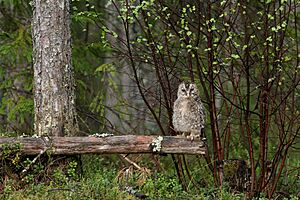
Parental Care and Traits
Young Ural owls become ready to breed the year after they leave their parents. However, in southern Finland, females often don't try to nest for the first time if it's a bad vole year. Most start breeding when they are 3 to 4 years old. Females who start breeding at 2 or 3 years old tend to have more successful babies over their lifetime. In Finland, females laid eggs about 2.7 times in their lives. They produced an average of 6.7 fledglings.
Mother Ural owls are known to fiercely defend their young. In Finland, their defense behavior is very consistent. It starts with a bark, then flying towards the threat, and finally attacking with powerful strikes. These attacks can cause serious harm to humans, even leading to eye injuries. Because of these attacks, very few Ural owls are preyed upon.
Breeding Success and Challenges
Sometimes, in broods with more than three chicks, one might die from siblicide (sibling killing sibling). But this is rare. Larger clutches might be a way to ensure some young survive, as younger siblings in big broods are more likely to die early. How well they breed depends a lot on how much prey is available. In Fennoscandia, vole populations go up and down every 3 years. This causes big changes in how many young owls are produced.
In Sweden, the number of fledglings per pair can range from zero to 2.9, with an average of 1.03-1.12. However, about 62% of young owls don't survive their first year. In southern Finland, the number of successful nests and fledglings also varied greatly with vole cycles. In high vole years, they averaged 3.5 fledglings per successful nest. In low vole years, it was 1.79.
Older female Ural owls (6 to 9 years old) tend to be more productive than younger ones. If pairs are given extra food, they nest earlier and lay more eggs. This shows that food availability affects how many young they produce.
In Slovenia, about 80% of breeding attempts produce at least one fledgling. A study there showed that late summer peaks of edible dormouse numbers helped increase breeding success. Parent Ural owls, especially the female, can adjust their breeding cycle to help their young survive. They are also good at dealing with parasites in nest boxes. Young owls released in Austria traveled an average of 8,778 m (28,799 ft) and had about a 23% death rate.
Ural Owl Status and Conservation
The Ural owl is not a very common bird, but it can be found in good numbers in some areas. The IUCN estimates there are between 350,000 and 1,200,000 Ural owls in the wild worldwide. In recent times, their numbers have dropped in areas where hollow and broken trees were removed from forests. In Estonia, managed forests have fewer Ural owls than undisturbed forests. This is because fewer snags and natural cavities are available for nesting.
However, the overall trend for most European Ural owl populations is positive. Building nest boxes has helped increase their numbers in several areas, especially in Finland. In eastern Europe, it is one of the more stable owl species. Several populations in central and eastern Europe have grown and expanded recently. For example, in the western Carpathian mountains, numbers grew from 1000 pairs in the 1980s to 3500 pairs by 2005. In the Czech Republic, numbers increased from 1-5 pairs in 1985–89 to 25-40 pairs by 2001–2003, partly due to reintroductions.
In some parts of Slovakia, the density of pairs can be as high as one pair per square kilometer. This might be the highest known density for the species. In Slovenia, the estimated number of pairs increased from 400-500 in 1973-1994 to 1400-2500 by 2006. In Finland, Ural owl numbers increased by about 1% between 1982 and 2007, while many other owl species declined. The Ural owl is the second most common breeding owl detected in Finland, after the boreal owl.
Sometimes, Ural owls fly into man-made objects. They are less likely to do this than other large birds of prey because they prefer remote forests. But some are killed by hitting wires or by electrocution. These deaths might increase as populations grow and move closer to human areas. Collisions with glass buildings and cars might also increase.
Historically, Ural owls were hunted to some extent. But they were spared the worst of it because they nested in remote forests. They also seemed to hunt less small domestic fowl than larger raptors like eagle-owls or golden eagles, which were heavily hunted. Like other wild birds, Ural owls can get diseases and infections. But these are unlikely to harm the overall population.
Bringing Ural Owls Back (Reintroduction)
Species reintroduction programs have been done in some parts of Europe. The best-known reintroduction was in the Bohemian forest, which spans Germany, the Czech Republic, and upper Austria. The Ural owl had disappeared from this area by 1926. Between 1972 and 2005, 212 young Ural owls were released from captive breeding. Scientists also placed young owls in tawny owl nests, and both tawny and Ural owls successfully raised them. Nest boxes were also set up to help.
The first wild breeding in the Bohemian forest happened in 1985. By the end of the study, at least 6 pairs were established. To have a self-sustaining population, at least 30 pairs are needed in the area. So, 87 birds were introduced to nearby Sumava National Park between 1995 and 2006.
A more successful reintroduction happened in the Vienna Woods in Austria. Between 2009 and 2013, 67 young owls were released. A network of 127 nesting boxes was set up. The survival rate was high, about 70.5%. By 2011–2012, 10 pairs tried to nest and produced 3.1 fledglings per successful pair.
|




